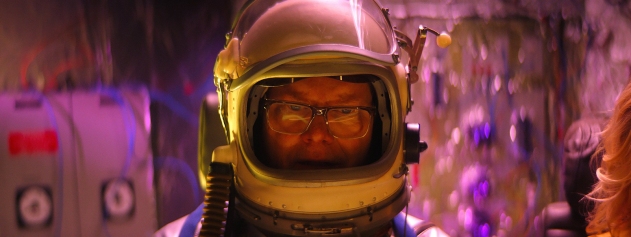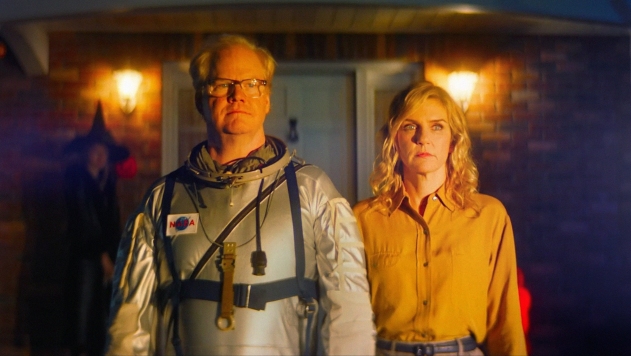
Winner of the Sloan Science on Screen Award at SFFILM, Colin West’s feature LINOLEUM stars Jim Gaffigan as host of a children’s science TV show who realizes he can change the trajectory of his life when a piece of a rocket falls from orbit into his neighborhood, prompting him to try building his own spaceship. The film also stars Rhea Seehorn, Katelyn Nacon, Tony Shalhoub, and Michael Ian Black. It will open in select theaters on February 24. We spoke with writer/director Colin West about his connection to the story, what it means to win a Sloan award, and the real rocket that made it into the film.
Please note: This interview contains some spoilers.
Science & Film: What is your perception of a “Sloan film” and why do you think LINOLEUM fits or doesn’t?
Colin West: There is a magic in LINOLEUM that is taking science and putting those principals into emotion. I’ve always loved Sloan films because I come from a house of science; my parents are both in the sciences—my mom worked for Big Tech and my dad is a computer scientist/mathematician. I watched Bill Nye outside of school I liked it so much. I like Sloan because I think there is this way of bringing sciences into the zeitgeist through cinema that really works. Museum of the Moving Image, you guys are the best. I’m trying to get to why I’m surprised LINOLEUM made it into this [won a Sloan prize] because most of the Sloan films that I’ve seen are grounded science, and this is elevated—this dude’s building a rocket ship in his garage, it’s crazy.
S&F: I think Sloan supports creative ways of weaving science into storytelling, and your film does that with a layered approach.
CW: I get that. Throughout LINOLEUM there is this science TV show that almost reframes what’s happening in the movie via a scientific idea. As things are starting to break down for these characters, suddenly the TV pops up and is like, this is what entropy is, the destruction of all things. That conceit taught me a lot about writing. Having something bigger than the story itself to kind of explain the story in a thematic way was helpful. Using these scientific terms to reframe the emotional things happening in the movie was the most important part [of writing]. The characters are humans that happen to be scientists. It was fun to workshop all of that together.

Jim Gaffigan in LINOLEUM
S&F: In terms of the writing process, what resources did you use to help you understand scientific terms or themes?
CW: I am a science nerd; if I wasn’t a filmmaker, I’d very likely be in the sciences, probably in astronomy. Oddly, I feel like I used scientific research as a huge procrastination tool for making this movie. I’d be like, I’ve gotta research this more before I can write it. A lot of the science that is in this move is literally elementary school science. I had an advisor named Dr. Paul Ronney who is an astrophysicist at USC and I collaborated with him. He read the script and I spoke with him about the feasibility of this storyline—can somebody actually make a rocket in their garage? Basically, he said none of this stuff could happen. But the interesting part was he gave me tips about the physics behind the action and I could take that and run with it in a lot of ways. He would often talk about how much fuel you need to lift a rocket into space, so being able to draw from those conversations and draw that back into the reality of the situation and the characters asking, where is your fuel? Giving those conversations a bit more grounding was helpful.
Jim Gaffigan, who plays the lead character, knows nothing about science. His character is very passionate about it, so he had to draw that passion from some other category in his life. He would often say that the excitement that he has around science in the movie was the excitement he had around comedy when he was a younger guy. He tried to take that and reframe it into this form of character-driven storytelling.
S&F: Can you speak more about how you worked with Jim? How important was it for you that he understand the concepts he’s talking about and the career of a scientist like the one he plays?
CW: There were times when Jim was really confident with it, around the scenes where he was building the rocket or having jargony talk on the TV show. He would come to me and ask me questions, but I think he was looking for the way in which I have had enthusiasm around it, rather than for me to explain these things logically. It contrasts a bit to Rhea Seehorn who plays the character of Erin. She did a lot of research. I remember her being like, wouldn’t it be the control module not the service module? That was its own form of collaboration too. I always say that as a director I like to treat my actors as department heads for their own character. Their whole existence for the five to six weeks we were shooting was focused on one character. I, on the other hand, was focused on the bigger picture. So, I love to collaborate with actors and trust them to build those characters on their own. Just like other department heads, we can work together to mold a bit, but it’s important to allow space for that to come to fruition. I love that each of these different actors had their own way of approaching science.

Jim Gaffigan and Rhea Seehorn in LINOLEUM
S&F: How did the production design come together?
CW: My production designer was Mollie Wartelle, and she and her team were above and beyond incredible. From the get-go, because the film is set in all these different time periods all at once without telling you until the end, what we kept talking about was setting the film in a tone not a time. It was one of the more fun challenges, figuring out how we could thread together 1968, 1991, and 2022.
As far as the rocketry, the rocket engine in the movie is one of the real Apollo rocket engines that was used as a backup. I befriended this guy Carlos who has a massive warehouse in the Valley in LA full of old rocketry parts. It’s called Norton Sales. I’ve been going for years to poke around. I went to him and asked if we could borrow a bunch of stuff, and he said yes. I ended up buying a box truck, stuffing it full of real rocketry parts, and driving it across the country to New York which is where we shot the movie. Of course, these parts were really impractical—that engine weighed at least a ton. We had to get forklifts to lift it all out.
S&F: That’s a trip. This is your second feature, is there anything in particular regarding science as a topic or theme that you think you’ll continue working with?
CW: Absolutely. Many years ago I made a short sci-fi film and someone asked about that too; they asked: why do all your films have to do with time and destruction or degradation? I didn’t even realize that until this person said it. Since then, I’ve realized that the scientific aspects that I’m drawn to are very existential questions. My next script that I just finished which I’m very excited about making is called NOW THEN OR POSSIBLY THE FUTURE. It’s like LINOLEUM in that there is this unreliable world happening, but it’s an ensemble story and about ten people who are dealing with entropy in their own ways. It’s sort of about how you combat something when it’s inevitable. So, I’m very interested in using science as theme, and my inclinations are a little less drawn to the scientific facts than, what does this mean for us?
♦
FILMMAKERS
PARTNERS
TOPICS